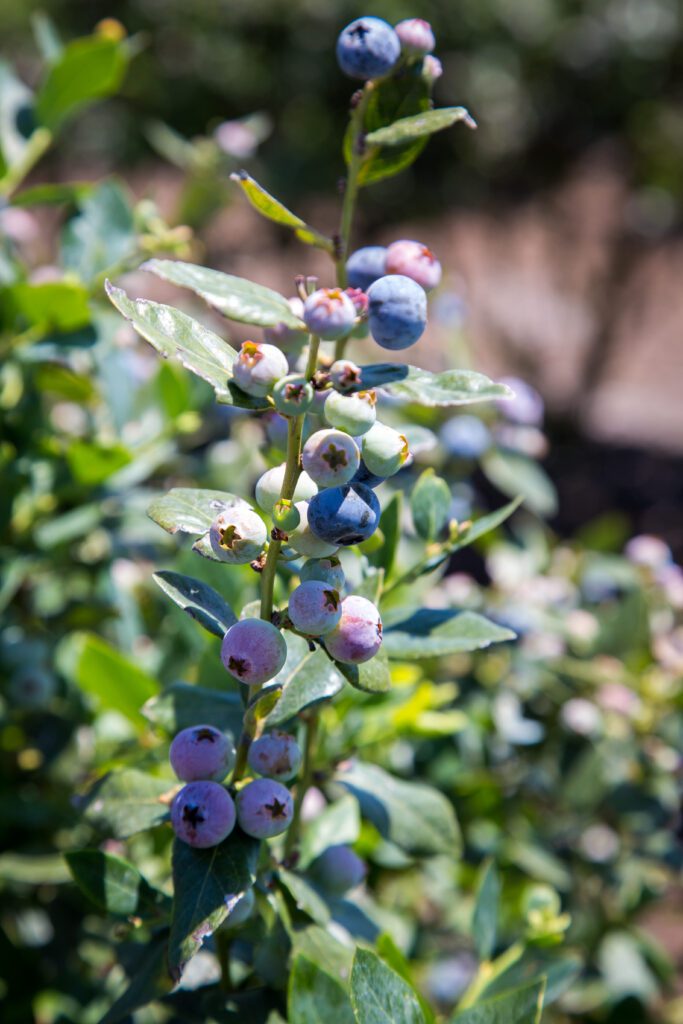Hurricanes Made This Year’s Harvest a Trying Time for Some Growers
by PAUL CATALA
During the past two years, Florida’s blueberry harvests weren’t great, but they weren’t
necessarily bad either. About 21 million to 21.5 million pounds were harvested from the
2021 and 2022 seasons on Florida’s approximately 5,500 acres of blueberry farmland.
But for the 2023 season, from the start of March through early May, it was a bit more
dreary as only 15.66 million pounds of blueberries were harvested from Florida farms –
down about 5.8 million pounds.
There are about 900 blueberry farms across Florida that employ approximately 2,500
workers and generate an annual economic impact of about $295 million.
Doug Phillips, UF/IFAS Blueberry Extension Coordinator, says the lower harvest
numbers are significant but not severe. He says a number of blueberry farms in South
Florida reported lower numbers due to Hurricane Ian, which ravaged southwest Florida
farms in late September of 2022.
“That was probably, in my opinion, a large part in the reduction of total pounds
harvested across the state,” he says.
Phillips, who has spent more than five years with the IFAS research center in Balm,
says growers in North and Central Florida had good seasons, though some reported
that freezing temperatures right before Christmas delayed fruit ripening.
“Other than that, I think that most of the growers in the central or northern part of the
state production-wise had decent seasons,” he adds.
Florida growers typically face stiffer competition as a result of Mexico importing
blueberries into the U.S. during Florida’s early market window. Additionally, Georgia
begins to add volume to the market toward the end of that window. Phillips says
Georgia berries came into the market earlier than usual this season because that state
didn’t experience any March freeze events.
As in the previous three to four Florida blueberry seasons, Florida producers had been
challenged by increasing production costs. Labor rates have increased by 16 percent in
some instances for harvesting crews in addition to a 50 percent increase in fertilizer
costs. Because consumers tend to buy less at higher prices, grower profit margins are
getting squeezed.
But that hasn’t hampered growth in the state’s blueberry industry. Over the past 20
years, more than 5,200 acres of land have been dedicated to growing blueberries,
making Florida eighth in the country in terms of production, according to IFAS. Florida
has the first U.S.-produced blueberries to reach the domestic market and most of the
state’s blueberry farms are found in Hendry, Alachua, and Putnam counties, in addition
to some in the Panhandle.
In Central Florida — primarily Polk, Orange, Pasco, Hernando, and Hillsborough
counties – blueberry acreage adds up to approximately 30 percent of Florida’s total
blueberry acreage.
Farther south, Jason Carlton of River Valley Farms in Arcadia says the 2022 hurricanes,
particularly Hurricane Ian, severely impacted his farm and its 45 acres. He says his
farm’s proximity to the storm’s landfall didn’t help.
“We were heavily impacted by the hurricane; it came right over our farm. We were
probably down 70 percent from last year in crop because of it. It’s been a pretty rough
year for us,” says Carlton, who is in his second year of growing blueberries. “I think
growers were impacted the closer they were to the storm.”
Looking ahead to the 2024 blueberry season, Carlton says he’s already hedged and
planted new varieties and “everything looks great,” although he adds he’s still hoping to
get some state and federal disaster relief for his blueberry operation.
“We’re glad this past season is behind us,” he says. “Everything’s coming back green
and looking pretty. We’re optimistic for next season.”
From her office in Gainesville, Brittany Lee, former executive director of the Florida
Blueberry Growers Association, says despite the late hurricanes and freezing
temperatures, the blueberry industry remained focused on fruit quality, harvesting, and
— most importantly — “delivering a safe, healthy product to our consumers.”
Lee, vice president of Florida Blue Farms — a 112-acre blueberry farm in Waldo near
Gainesville — and a member of the U.S. Highbush Blueberry Council, says she hopes
favorable weather will help boost production for the 2024 blueberry season. She says
the state’s blueberry growers provide jobs and promote trade while focusing on
protecting the state’s environment and natural resources. In 2024, she says growers
and association members will continue to modernize operations and work closely with
the IFAS blueberry breeding program to cultivate and release new blueberry varieties.
“We will reclaim our position to lead the spring marketplace with the first domestic
blueberries available to U.S. consumers,” she says.

